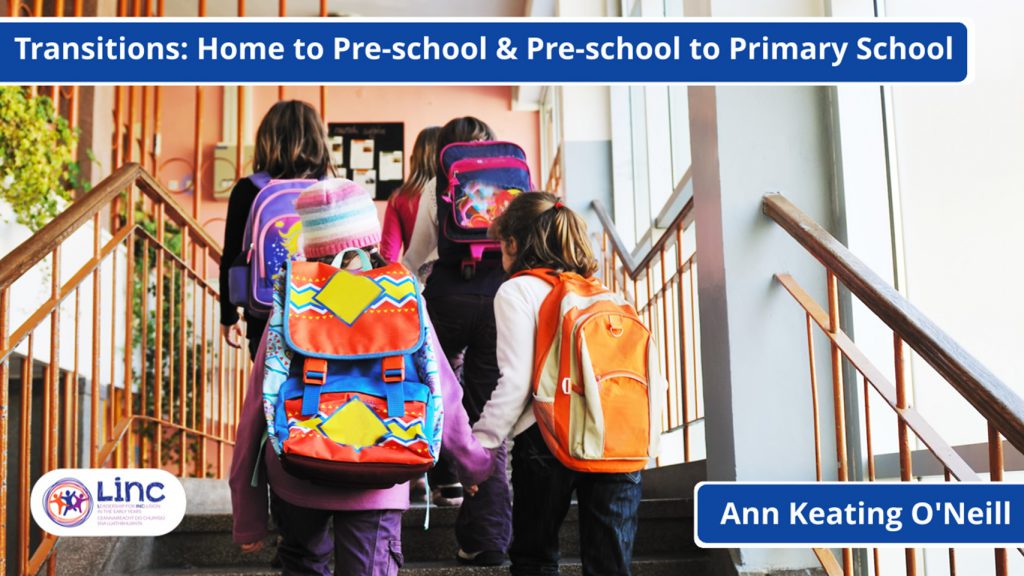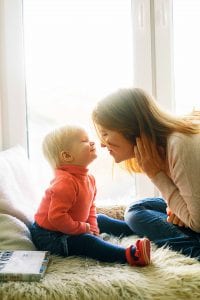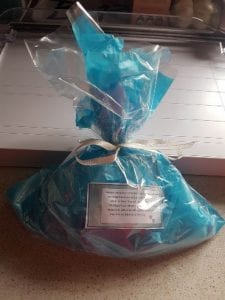In this edition of the LINC blog, Ann Keating O’Neill, LINC Graduate and Owner/Manager of Shining Stars Preschool Lisronagh, Co. Tipperary, describes how she manages the two major transitions for children in her setting.

I have always put a lot of thought into the importance of transitions for children during my years as an early years’ teacher. One of the most important transitions for me has always been the transition from home to pre-school.
During my LINC training, I had a lot of time to reflect on our transition policy to ensure it was inclusive of the needs of all children. Every year we have an open morning, where we invite parents and their children to come and meet with the teachers and to become familiar with our pre-school room.
Children are free to use all the resources within the room and they naturally gravitate towards their own area of interest. This could be animals, cars, dinosaurs, the creative area, construction area, puzzles etc; or just sitting on a chair observing the other children at play. It affords us the opportunity as teachers to get to know each of the children a little that day through interactions and observations. It gives parents time to meet us and to discuss any specific needs that their child may have, or any concerns they may have around their child’s transition to pre-school. After all, this is the first step on their educational journey.
We have several resources that we share with parents to support them with the transition, such as:
- Our settings brochure detailing our curriculum statement
- Our settings ethos and information about our setting
- Our personalised brochure on AIM which I put together as part of my LINC training
- Aistear Curriculum Framework parental handout and other literature

For parents, having their child start pre-school whether it is their first or last child, is a huge transition and major step for parents too. They need reassurance that we will do everything to ensure that their child is safe and happy and fully included in all aspects of their learning environment.
A child profile form is given to parents prior to the start of the year to enable us to gather important information on each child. This includes information on: their family circle, their favourite toys, colours, food, areas of interest and any areas of difficulty they may have. Health and vaccination details are also included. This form enables us to plan out our resources in the room at the beginning of the year before the children first arrive at pre-school. It gives us time to put strategies in place to ensure an inclusive environment for the children settling in and getting to know each other. It also allows us to put in place resources planned around the children’s interests from their individual profiles.
On our first day, we meet and greet all the children and their parents and support the children with getting to know their new environment. The children hang up lunch boxes under their name stars as we engage with them, asking if they had seen our wobble bikes outside and if they would like to leave on their coats and go cycling etc. outside. We further support children by helping them to put on their cycling helmets if they wish to go on the bikes, which they usually do. We can have one or two children in the following few days who are slightly unsettled at first, but the “magic wave/funny face” strategy where the parents make funny faces in the window as they leave works a treat. By week two the children run in and go straight to greet their friends.
Studying on the LINC programme has made me further reflect on how we can ensure that all children are enabled to feel secure, happy and content in our setting. To support this we have added a visual schedule for the children to become familiar with the sequence of our day. It allows us to change the pictures around for the children to see what activity is happening next. We incorporate lots of outdoor play, which varies from day to day with different activities.
We have reduced our daily transitions down to the bare minimum and this works so well for all the children. We have arrival, free play outdoors, hand wash/lunch, free play indoors (this includes the option of small group/story-time), then it’s home time. We sing when we need to let the children know that a transition will soon be happening to give them time to finish an activity.
Our first theme when they children begin is “I am special, because I am me”. We are continuously observing the children, ensuring they are happy, settling in and making friends. We are also planning additional resources around their interests. While studying on the LINC programme, I added a lot of new books to our library to reflect difference and promote inclusion and diversity. The children have begun to make new friends and have shown great interest in animals and small-world resources. There are fun times ahead as we enjoy our year of “learning through play while having fun.”
Transition to primary school
We have put in place a new transition policy for the parents of children transitioning to primary school. As part of this policy we send a monthly newsletter, and it has proven to be a great way to develop a strong partnership with parents. At the beginning of the year we began to include information in the newsletter on important things that parents should know for the transition to be a smooth one, especially for each child i.e. we never use the words “leaving or going” we say, “moving to school”. We are very lucky that our preschool is on the grounds of our local national school. The school Principal drops in throughout the year and all the children are very familiar with her being in the room. The children also visit the school during the year and they get to meet with their new teacher.
We put together a transition form, where we asked parents to get their child’s permission for their information to be passed on to the school. The parents are then asked to use the child’s section of the form to have their child’s voice heard on things such as: what it was they were looking forward to in “school” or any worries they had, their favourite activities, likes and dislikes etc. There was also a section where parents were asked to answer similar questions on any aspirations/worries they may have and return the form to us. The final section was for the early childhood teachers to input information about each child’s strengths, abilities, special areas of interest, their dispositions, friends and any concerns/wishes they had regarding this transition. We also included any strategies which we had used throughout the year.
The primary school teacher visits on our last week in preschool and she chats to each of the children while they are at play and the interactions are very natural. With the parents’ consent, I give the teacher a folder that includes each child’s transition form and this enables the teacher to plan for the needs of every child in her class, for their first day in school and the year ahead.
We have our graduation day in June and the children dance and sing their chosen songs. This was how they chose to celebrate their transition. It was our best graduation to date as it was fully child-led and such fun. On our last day as the children said ‘Slán’ it was a day of mixed emotions for us staff and parents.
The final part of our transition programme was to send a pack with two “thinking of you” bands in the post with a note to each child. One band to be worn by the child and one by Mum and Dad, who could share them. These packs were well received by both the children and their parents and it is something which we will continue to do in the future. It is nice to hear your name being called each morning as the children pass, to see them run in the primary school door and to know that they are happy and settled.
![]()
